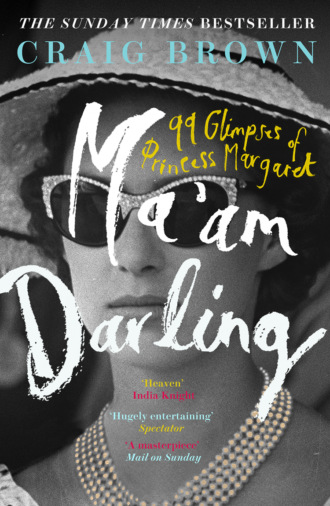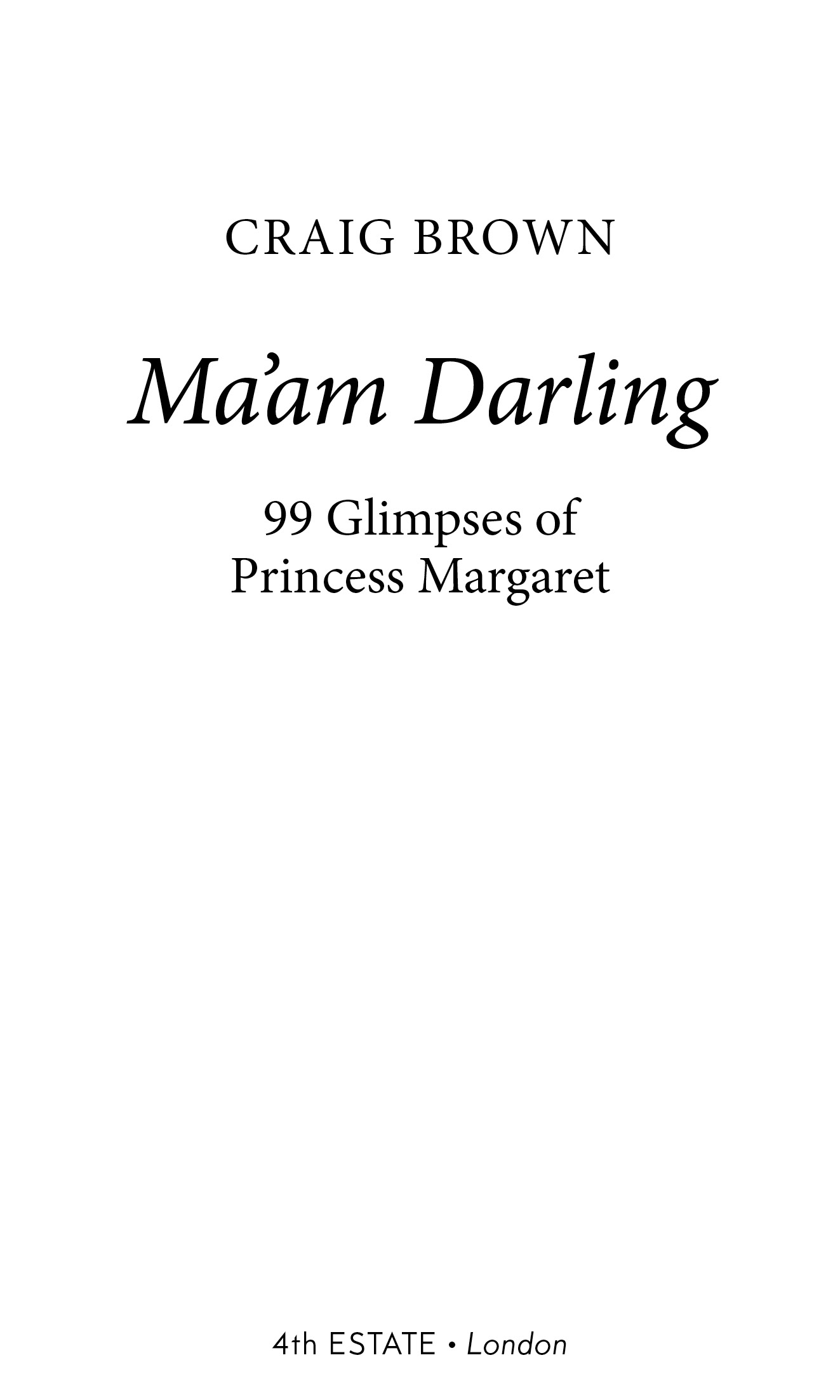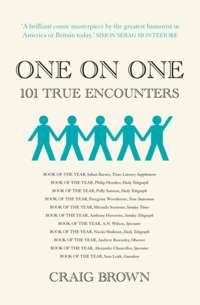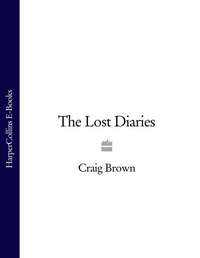
Полная версия
Ma’am Darling: 99 Glimpses of Princess Margaret


COPYRIGHT
4th Estate
An imprint of HarperCollinsPublishers
1 London Bridge Street
London SE1 9GF
www.4thEstate.co.uk
This eBook first published by 4th Estate in 2017
Copyright © Craig Brown 2017
Craig Brown asserts the moral right to be identified as the author of this work
A catalogue record for this book is available from the British Library
Cover design by Anna Morrison
While every effort has been made to trace and contact copyright-holders, in some cases this has proved impossible. The author and publisher would be grateful for any information that would enable any omissions to be made good in future editions of this book.
All rights reserved under International and Pan-American Copyright Conventions. By payment of the required fees, you have been granted the non-exclusive, non-transferable right to access and read the text of this e-book on-screen. No part of this text may be reproduced, transmitted, down-loaded, decompiled, reverse engineered, or stored in or introduced into any information storage and retrieval system, in any form or by any means, whether electronic or mechanical, now known or hereinafter invented, without the express written permission of HarperCollins.
Source ISBN: 9780008203634
Ebook Edition © September 2017 ISBN: 9780008203627
Version: 2018-05-23
DEDICATION
For my mother, Jennifer, born five days later; with love
EPIGRAPH
My dreams
Watching me said
One to the other:
‘This life has let us down.’
Paul Potts
Boredom: the desire for desires.
Leo Tolstoy
The love of place, and precedency, it rocks us in our cradles, it lies down with us in our graves.
John Donne
CONTENTS
Cover
Title Page
Copyright
Dedication
Epigraph
1
2
3
4
5
6
7
8
9
10
11
12
13
14
15
16
17
18
19
20
21
22
23
24
25
26
27
28
29
30
31
32
33
34
35
36
37
38
39
40
41
42
43
44
45
46
47
48
49
50
51
52
53
54
55
56
57
58
59
60
61
62
63
64
65
66
67
68
69
70
71
72
73
74
75
76
77
78
79
80
81
82
83
84
85
86
87
88
89
90
91
92
93
94
95
96
97
98
99
Acknowledgements
Sources
Other Books by Craig Brown
About the Author
About the Publisher
1
21 August 1930
‘Her Royal Highness The Duchess of York gave birth to a daughter this evening. Both Her Royal Highness and the infant Princess are making very satisfactory progress.’
31 October 1955
‘I would like it to be known that I have decided not to marry Group Captain Peter Townsend. I have been aware that, subject to my renouncing my rights of succession, it might have been possible for me to contract a civil marriage. But mindful of the Church’s teachings that Christian marriage is indissoluble, and conscious of my duty to the Commonwealth, I have resolved to put these considerations before others. I have reached this decision entirely alone, and in doing so I have been strengthened by the unfailing support and devotion of Group Captain Townsend. I am deeply grateful for the concern of all those who have constantly prayed for my happiness.’
21 May 1958
‘The Press Secretary to the Queen is authorised to say that the report in the Tribune de Genève concerning a possible engagement between Princess Margaret and Group Captain Peter Townsend is entirely untrue. Her Royal Highness’s statement of 1955 remains unaltered.’
26 February 1960
‘It is with the greatest pleasure that Queen Elizabeth the Queen Mother announces the betrothal of her beloved daughter The Princess Margaret to Mr Antony Charles Robert Armstrong-Jones, son of Mr R.O.L. Armstrong-Jones Q.C., and the Countess of Rosse, to which union the Queen has gladly given her consent.’
19 March 1976
‘HRH The Princess Margaret, Countess of Snowdon, and the Earl of Snowdon have mutually agreed to live apart. The Princess will carry out her public duties and functions unaccompanied by Lord Snowdon. There are no plans for divorce proceedings.’
10 May 1978
‘Her Royal Highness The Princess Margaret, Countess of Snowdon, and the Earl of Snowdon, after two years of separation have agreed that their marriage should formally be ended. Accordingly Her Royal Highness will start the necessary legal proceedings.’
9 February 2002
‘The Queen, with great sadness, has asked for the following announcement to be made immediately. Her beloved sister, Princess Margaret, died peacefully in her sleep this morning at 6.30 in the King Edward VII Hospital. Her children, Lord Linley and Lady Sarah Chatto, were at her side. Princess Margaret suffered a further stroke yesterday afternoon. She developed cardiac problems during the night and was taken from Kensington Palace to the King Edward VII Hospital at 2.30 a.m. Lord Linley and Lady Sarah were with her and the Queen was kept fully informed throughout the night. Queen Elizabeth, the Queen Mother, and other members of the Royal Family are being informed.’
For Immediate Release
Monday, 10 April 2006
London – Christie’s announces that jewellery and works of art from the Collection of Her Royal Highness The Princess Margaret, Countess of Snowdon, will be sold in London on 13 and 14 June 2006. This important and unparalleled historic sale will celebrate and pay tribute to Princess Margaret’s renowned beauty, style and taste. Comprising over eight hundred items, with estimates ranging from under £100 to over £500,000, the auction will feature a superb selection of jewellery and Fabergé as well as a broad range of furniture, silver, works of art and decorative objects.
2
Yet, perhaps, in the secret chambers of consciousness, she had her thoughts, too. Perhaps her fading mind called up once more the shadows of the past to float before it, and retraced, for the last time, the vanished visions of that long history – passing back and back, through the cloud of years, to older and even older memories – to the warm clasp of Crawfie, so full of do’s and don’ts; to Sir Roy Strong’s strange clothes and high demeanour; and her last afternoon tea with Peter; and Tony dancing attendance on her mother; and Roddy emerging from the sea at Mustique in his brand-new trunks; and the audience hooting with laughter at Dusty Springfield’s impertinent aside; and President Johnson steering her into dinner in the White House, his right palm lingering perhaps a little too long on her royal behind; and the old Queen, her grandmother, reprimanding her for erratic behaviour with a bouncing ball; and Lilibet’s voice down the telephone reassuring her once more that no harm had been done; and her mother laughing and saying ‘Such fun!’ before giving her that pitying look, and her father on his final evening bidding her good night, and see you in the morning.
3
Yoo-hoo!
Coo-EEEE!
She shows up without warning, popping her head around the door of every other memoir, biography and diary written in the second half of the twentieth century. Everyone seems to have met her at least once or twice, even those who did their best to avoid her.
I first noticed her ubiquity when I was researching another book. Wherever I looked, up she popped. Can you spot her here, in the index to Andy Warhol’s diaries?
Mansfield, Jayne
Manson, Charles
Mao Zedong
Mao Zedong, Mrs see Chiang Ching
Mapplethorpe, Robert
Marciano, Sal
Marcos, Ferdinand
Marcos, Imelda
Marcovicci, Andrea
Marcus, Stanley
Margaret, Princess
Marianne (Interview staff)
Marilyn (Boy George’s friend)
Or here, in the diaries of Richard Crossman?
Malta, withdrawal from
Management Committee
Manchester water supply
Manchester Junior Chamber of Commerce
Margach, James
Margaret, Princess
Marina, Princess
Marquand, David
Marre, Sir Alan
Marriott, Peter
It is like playing ‘Where’s Wally?’, or staring at clouds in search of a face. Leave it long enough, and she’ll be there, rubbing shoulders with philosophers, film stars, novelists, politicians.
I spy with my little eye, something beginning with M!
Here she is, sitting above Marie Antoinette in Margaret Drabble’s biography of Angus Wilson:
Maraini, Dacia
Marchant, Bill (Sir Herbert)
Maresfield Park
Margaret, Princess
Marie Antoinette
Market Harborough
And here, in the diaries of Kenneth Williams:
Manson, Charles
March, David
March, Elspeth
Margaret, Princess
Margate
Margolyes, Miriam
Would she rather have been sandwiched for eternity between Maresfield Park and Marie Antoinette, or Elspeth March and Margate? I’d guess the latter was more her cup of tea, though as luck would have it, there is a Princess Margaret Avenue in Margate,* named in celebration of her birth in 1930, so, like it or not, her name, rendered both topographical and tongue-twisting, will be forever linked to Margate.
Why is she in all these diaries and memoirs? What is she doing there? In terms of sheer quantity, she could never hope to compete with her sister, HM Queen Elizabeth II, who for getting on for a century of brief encounters (‘Where have you come from?’ ‘How long have you been waiting?’) must surely have met more people than anyone else who ever lived. Yet, miraculously, the Queen has managed to avoid saying anything striking or memorable to anyone. This is an achievement, not a failing: it was her duty and destiny to be dull, to be as useful and undemonstrative as a postage stamp, her life dedicated to the near-impossible task of saying nothing of interest. Once, when Gore Vidal was gossiping with Princess Margaret, he told her that Jackie Kennedy had found the Queen ‘pretty heavy going’.
‘But that’s what she’s there for,’ explained the Princess.
* At present the headquarters of the mobile hairdresser ‘Haircare at Home by Sharon’. As it happens, HRH Princess Margaret was fond of visiting her own hairdresser, almost to the point of addiction, often popping in twice in one day.
4
In her distrust of the unexpected, the Queen has taken a leaf from her grandfather’s book. King George V liked only what was predictable, regarding everything else as an infernal nuisance. A typical diary entry begins with an account of the weather (‘a nice bright morning, but strong wind’), accompanied, where appropriate, by a frost report (‘seven degrees frost this morning’). It then chronicles the exact time he had breakfast (‘up at 6.45, breakfast at eight with May’), and briefly mentions anyone notable he has encountered, and any advances he has made with his 325 stamp albums (‘The Prime Minister came to see me and we had a long talk. Spent the afternoon with Bacon choosing more stamps’). And that’s it. He disdains any sort of detail, telling or otherwise, about people and places. World events play second fiddle to stamps, clocks, barometers and bedtime. ‘The poor archduke and his wife were assassinated this morning in Serbia. They were in a motorcar. Terrible shock for the Emperor …’ he writes on the evening of 28 June 1914. He then adds: ‘Stamps after lunch, bed at 11.30.’
Few people have ever transcribed a conversation with his eldest granddaughter. Some remember what they said to the Queen, but have no memory of what she said to them, or indeed if she said anything at all. Gyles Brandreth is one of the few exceptions. At a drinks party in 1990, he found himself alone with her in a corner of the room. ‘There was no obvious means of escape for either of us, and neither of us could think of anything very interesting to say.’
But he didn’t leave it there. When he got home, he recorded their exchange in his diary:
GB (GETTING THE BALL ROLLING): Had a busy day, Ma’am?
HM (WITH A SMALL SIGH): Yes, very.
GB: At the Palace?
HM (SUCKING IN HER LIPS): Yes.
GB: A lot of visitors?
HM (APPARENTLY BITING THE INSIDE OF HER LOWER LIP): Yes.
(PAUSE)
GB (BRIGHTLY): The Prime Minister? (John Major)
HM: Yes.
(PAUSE)
GB: He’s very nice.
HM (NODDING): Yes, very.
(LONG PAUSE)
GB (STRUGGLING): The recession’s bad.
HM (LOOKING GRAVE): Yes.
GB (TRYING TO JOLLY THINGS ALONG): I think this must be my third recession.
HM (NODDING): We do seem to get them every few years … and none of my governments seems to know what to do about them.
(A MOMENT OF TINKLY LAUGHTER FROM HM, A HUGE GUFFAW FROM GB, THEN TOTAL SILENCE)
GB (SUDDENLY FRANTIC): I’ve been to Wimbledon today.
HM (BRIGHTENING BRIEFLY): Oh, yes?
GB (DETERMINED): Yes.
HM: I’ve been to Wimbledon, too.
GB (NOW WE’RE GETTING SOMEWHERE): Today?
HM: No.
GB (OH WELL, WE TRIED): No, of course not. (PAUSE) I wasn’t at the tennis.
HM: No?
GB: No, I was at the theatre. (LONG PAUSE) Have you been to the theatre in Wimbledon?
(PAUSE)
HM: I imagine so.
(INTERMINABLE PAUSE)
GB (A LAST, DESPERATE ATTEMPT): You know, Ma’am, my wife’s a vegetarian.
HM (WHAT WILL SHE SAY?): That must be very dull.
GB (WHAT NEXT?): And one of my daughters is a vegetarian, too.
HM (OH NO!): Oh, dear.
Her technique is to let others do the talking. Often – perhaps more often than not – the dizzying experience of talking to a stranger more instantly recognisable than your own mother, a stranger the back of whose miniaturised face you have licked countless times, is enough to start you spouting a stream of gibberish. While you do so, Her Majesty may occasionally say, ‘Oh, really?’ or ‘That must be interesting,’ but most of the time she says nothing at all.
As a drama student in the mid-seventies, I found myself presented to her at a party, quite unexpectedly. Our host – who later explained that he thought she might want to meet one of the younger generation – told Her Majesty that I had recently had an article published in Punch, and then left us to it. ‘That must be interesting,’ she said. This was more than enough to convince me of her thirst to know more. Within seconds I was regaling her with my various complex and no doubt impenetrable theories of humour, while every now and then she was urging me on with an ‘Oh, really?’ or a ‘That must be interesting,’ and from there I proceeded to remind her of Bertolt Brecht’s theories of alienation (‘Oh, really?’), with particular reference to their application to comedy (‘That must be interesting’).
I have learned since that the way the Queen signals the end of a conversation is to take one step backwards, but I did not know this at the time. Friends who witnessed our meeting from the other side of the room told me that, during the final half of my discourse on Brecht, Her Majesty took first one step back, then another, then another, then another, but still found herself trapped: for each of her steps back I took a step forward.
Throughout her life, the Queen’s technique of giving nothing away has paid dividends. Nowadays, everyone seems content to interpret her silence as wisdom. The less she says, the more we believe she has something to say. Peter Morgan’s play The Audience and his film The Queen are both predicated on this paradox: her advisers and her prime ministers may prattle away, but, Buddha-like, it is Her Majesty the Queen, with her How long have you been heres? and her Have you come fars?, who remains the still, small voice of calm, radiating common sense.
But her younger sister was another matter. As the second-born, the also-ran, she was denied the Chauncey Gardiner option. She could never have been another whitewashed wall, there for people to see in her whatever they chose to see. To impress on people that she was royal, Princess Margaret had to take the only other path available to her: to act imperiously, to make her presence felt, to pull well-wishers up short, to set strangers at their unease. If I had tried to tell Margaret about Bertolt Brecht she would have interrupted me – ‘Too tiresome!’ – before I had got to the end of the ‘Bert –’. Like a grand guignol version of her elder sister, she took a perverse pleasure in saying the wrong thing, ruffling feathers, disarming, disdaining, making her displeasure felt. One socialite remembers seeing her at a party at Sotheby’s in 1997. By that stage, people were so reluctant to be snapped at by her that there was a sort of compulsory rota system in operation. A senior Sotheby’s figure told the socialite that he would guarantee him an invitation to every future Sotheby’s party attended by Princess Margaret if he would promise to talk to her for five minutes on each occasion.
Compare the Queen’s conversation with Brandreth to Princess Margaret’s dinner-party conversation, as witnessed by Edward St Aubyn and recreated in his wonderfully beady novel, Some Hope.
As the main course arrives, the Princess asks her host, Sonny, ‘Is it venison? It’s hard to tell under this murky sauce.’ A few minutes later, the French ambassador, sitting next to her, accidentally flicks globules of the sauce over the front of the Princess’s blue tulle dress.
‘The Princess compressed her lips and turned down the corners of her mouth, but said nothing. Putting down the cigarette holder into which she had been screwing a cigarette, she pinched her napkin between her fingers and handed it to Monsieur d’Alantour.
‘“Wipe!” she said with terrifying simplicity.’
While the ambassador is on his knees, dipping his napkin in a glass of water and rubbing the spots of sauce on her dress, the Princess lights a cigarette and turns back to her host.
‘I thought I couldn’t dislike the sauce more when it was on my plate.’
The ambassador’s wife offers to help.
‘He spilled it, he should wipe it up!’ replies the Princess. She points to a spot the ambassador has missed. ‘Go on, wipe it up!’ She then complains about ‘being showered in this revolting sauce’. At this point, the table falls silent.
‘“Oh, a silence,” declared Princess Margaret. “I don’t approve of silences. If Noël were here,” she said, turning to Sonny, “he’d have us all in stitches.”’
Before long, Sonny’s seven-year-old daughter appears, having found it hard to get to sleep. Her mother asks the Princess if she may present her.
‘“No, not now, I don’t think it’s right,” said the Princess. “She ought to be in bed, and she’ll just get overexcited.”’
5
More often than not, the presence of
Margaret, HRH the Princess
in an index signals yet another tale of haughty behaviour. In the autobiography of Cherie Blair she comes between Mandela, Nelson and May, Brian. The brittle wife of the former prime minister recalls the occasion she was talking to Princess Margaret at a gala performance at the Royal Opera House when the secretary of state for culture came over.
‘Have you met Chris Smith, our culture secretary, Ma’am?’ asked Mrs Blair. ‘And this is his partner …’
‘Partner for what?’ said the Princess.
At this point, writes Cherie Blair, ‘I took a breath.’
‘Sex, Ma’am.’
This reply proved unwelcome. ‘She stalked off.’ But Mrs Blair remains unapologetic. ‘She knew exactly what kind of partner I meant. She was just trying to catch me out.’
Most of the stories follow another arc: the Princess arrives late, delaying dinner to catch up with her punishing schedule of drinking and smoking. At the table, she grows more and more relaxed; by midnight, it dawns on the assembled company that she is in it for the long haul, which means that they will be too, since protocol dictates that no one can leave before she does. Then, just as everyone else is growing more chatty and carefree, the Princess abruptly remounts her high horse and upbraids a hapless guest for over-familiarity: ‘When you say my sister, I imagine you are referring to Her Majesty the Queen?’
At such moments it is as though she has been released by alcohol from the constrictions of informality. After a succession of drinks she is able to enter a stiffer, grander, more subservient world, a world in which people still know their place: the world as it used to be.
She had a thirst for the putdown, particularly where food and drink were concerned. Kenneth Rose,* the biographer of King George V, recorded her curt response when Lord Carnarvon offered her a glass of his very rare and precious 1836 Madeira: ‘Exactly like petrol.’ The author and photographer Christopher Simon Sykes remembers her arrival at his parents’ house one teatime. Full of excitement, the staff had prepared a scrumptious array of cakes, scones and sandwiches. The Princess glanced at this magnificent spread, said ‘I HATE tea!’ and swanned past.




